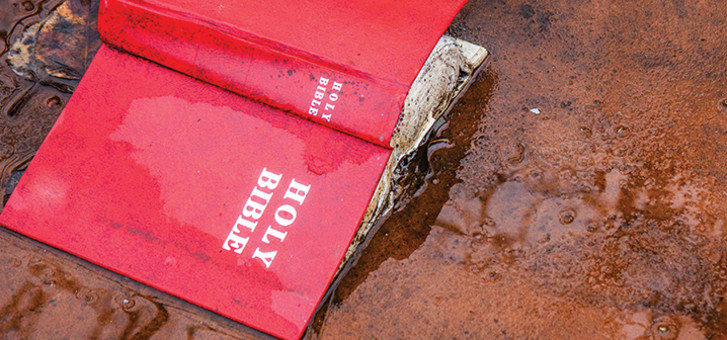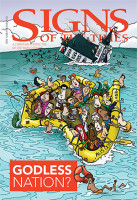Christianity is losing ground in Australia. That’s what last year’s census statistics release told us. Every five years, the census gives a broad picture of Australian society in numbers. Each census has questions about religion—the only non-compulsory section.
Some suggest that two things skewed the latest census and lowered the number of those affirming their faith. The first is that, for the first time, the “no religion” option was put at the top of the list, favouring it in the same manner that produces a “donkey vote” in a general election.
The other factor was a campaign by the Atheist Foundation of Australia (AFA) encouraging people to tick the “no religion” box if they had no meaningful personal faith. AFA president Kylie Sturgess called for political leaders to listen to the nonreligious constituency when it came to public policy. She said she wanted policy based on evidence, not on religious beliefs.1
Whatever the reason, the biggest change in the religious landscape of Australia has been in the growth of those claiming “no religion”. The census results show that an additional 2.2 million people reported having no religion compared to the 2011 census. Now, 30.1 per cent (7 million) of Australians say they have no religion. That’s 30.1 per cent compared to a miniscule 0.8 per cent in 1966 and 12.9 per cent in 1991—a dramatic increase. At the same time, Christianity fell from 88.2 per cent in 1966 and 74.0 per cent in 1991, to 52.1 per cent in the 2016 census.
Gary Bouma2 from Monash University notes that just to keep up with population growth any religious group needs to grow by 8.8 per cent. That makes the loss even more dramatic. However, he points out that only 9.6 per cent refused to answer the optional religious question, which tells us that “religious identity is still of interest to Australians”. Then again, marking “no religion” may not mean “someone is anti-religious, lacking in spirituality, or an atheist.” It could just mean they don’t “identify with a particular organised form of religion”.
A major change to Australia’s religious mix came when the White Australia Policy was abolished in 1966. Migration after that tended to come from non-European countries where non-Christian religions are common. By 1991, those affiliated with a non-Christian religion stood at just 2.6 per cent of the population. Now, 25 years later, that has increased to 8.2 per cent. Hinduism had the most significant growth between 2006 and 2016, driven by immigration from South Asia. Yes, Australia’s fastest-growing religion is Hinduism!
The rise of atheism
Researcher Bernard Salt3 notes that the number of atheists has increased by 45 per cent since the 2011 census and suggests three possible reasons for this. He sees that Australians may be becoming a “godless and self-centred people more concerned about our quality of life rather than eternal salvation”. Or perhaps they’re turning away from Christian churches after revelations of child abuse by clergy. But he’s more persuaded by the argument that, in the past, many may have identified themselves with a certain denomination—out of a sense of family or ethnic loyalty, perhaps—but didn’t officially belong to or attend that church. Now they’re indicating the reality and, he suggests, “Finally there is relief, there is honesty, there is a break with the religious affiliations of our youth.”
Even if that is so, the number of atheists has increased across all age groups. Salt is surprised that 600,000 of the 65-and-over age group are self-proclaimed atheists. This “rise of godlessness” is impacting on “ageing, fast-fading baby boomers who increasingly are mindful of what may, or what may not, lie beyond the great abyss.”
The death of religion
While the latest Australian census may cause Christians concern, Christianity is far from dying. World Vision’s Tim Costello, in his book Faith, says: “In this most secular nation there are far more Australians in church each Sunday than all the crowds attending professional football and other sports each week. That will come as a surprise to many, as we all know what a sports-obsessed nation we are.”
He adds that 23 of the 25 biggest charities in Australia are Christian. “The church’s organisations continue to do much of the heavy charitable lifting in a proudly secular nation.”4 And that raises the question of what groups will take up these tasks if Christianity continues to fade.
Looking at the broader picture, social researcher Hugh Mackay5 warns: “Anyone predicting the death of religion . . . would be missing not only the lessons of history, but also the present situation globally. About 73 per cent of the world’s population identify with one of the four great world religions: Christianity, Islam, Hinduism and Buddhism.” Estimates are that the number will rise to 80 per cent by 2050. And trends point to China becoming the world’s largest Christian and Muslim country. The World Religion Database highlights that the number of atheists reached its peak in about 1970, when state-sponsored atheism was at its most effective in Communist countries. As Communism crumbled in most places, atheism declined.6 And while birth-rates remain healthy in developing countries where religious adherence is high, comparatively godless Anglo-European populations are ageing or even shrinking.
The challenge for Christianity
Added to the findings of the census, an October 2017 Ipsos poll7 found that almost two out of three (63 per cent) Australians felt that religion did more harm than good. “Australia is one of the more negative countries regarding the perceived harm that religion does,” reports David Elliot from Ipsos. Only Belgium, at 68 per cent, was higher. The poll also found that only 25 per cent of Australians felt that religious people made “better citizens”. But is this possibly a result of respondents actually not knowing many active Christians as neighbours, there being so few of them?
Possibly so, because when they do—and this is heartening—most Australians (84 per cent) report feeling “completely comfortable” around people with different beliefs to their own. “In this regard, we are among the more tolerant nations globally,” says Elliot. “This tolerance may reflect our multicultural society or may be driven by beliefs that negative impacts of religion are more an issue globally than locally.”
Whatever the reason, the census and this poll are a challenge for those of us who value and follow Christianity. It no longer has the number of supporters it once did and the trend will probably continue. How do Christians respond?
One promising possibility is found in a question posed by Tim Costello who asks: “Could the unpopularity of the church be due to people’s reasonable expectation that the church should be more like Jesus?”8
Christians being more like their Christ? Now, that would make a difference. Actually, if every Christian was more like Christ, I can imagine growth in appreciation for Christianity. The next census may even see Christianity gaining ground.
4. Tim Costello, Faith, Hardie Grant Books, Richmond,Victoria, 2016, p 254.
5. https://johnmenadue.com/hugh-mackay-what-the-census-really-said-about-religion/
8. Tim Costello, Faith, Hardie Grant Books, Richmond,Victoria, 2016, p 255.







